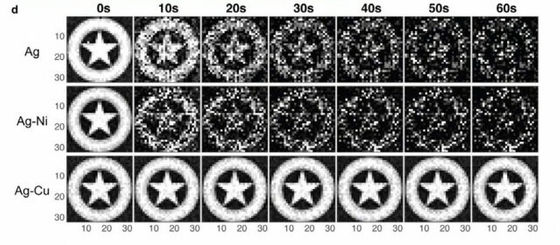A 'brain-like chip' that can store information like the human brain will be developed

A chip that can store information like a human brain by a research team at the Massachusetts Institute of Technology (MIT) by arranging tens of thousands of passive elements called ``
Alloying conducting channels for reliable neuromorphic computing | Nature Nanotechnology
https://www.nature.com/articles/s41565-020-0694-5
Engineers put tens of thousands of artificial brain synapses on a single chip | MIT News
http://news.mit.edu/2020/thousands-artificial-brain-synapses-single-chip-0608
A typical transistor switches between two values, '0' and '1', according to a specific charge to transmit information, and this transistor drives modern computers. The memristor works similarly to the transistor, but the memristor has the characteristic that the signal to be transmitted changes depending on the strength of the signal to be received, and a single memristor can output multiple values. is. Therefore, memristors can perform a wider range of operations than common transistors.
This time, the research team paid attention to the synapse-like characteristic of the memristor, which 'memorizes a specific current and its corresponding value and outputs the same value when the next current of the same intensity is received.' We have created a chip that is smaller and has higher performance than the one using conventional transistors.
The existing memristor was designed to connect the positive electrode side and the negative electrode side, which are made of different materials, by a 'conduction channel' that bridges them. However, when a large voltage is applied or a large amount of ions flow in, the conduction channel operates normally, but when the thickness of the conduction channel is reduced or the voltage is lowered, the operation of the conduction channel is not stable. There was a problem.
The research team solved this problem with knowledge of metallurgy. Since silver is used for the positive electrode of the memristor and silicon is used for the negative electrode, copper, which is a material that is compatible with both silver and silicon, was selected as a new material. By sandwiching copper between the positive electrode and the negative electrode, the conduction channel was stabilized, and a chip of 1 square millimeter size composed of tens of thousands of memristors was created.

In order to test the created tip, an experiment was conducted to 'remember the tip to remember the image of
Below is an image of Captain America's shield that Chip remembered. For comparison, the results of chips using memristors made of different materials are lined up in the upper and middle rows, and the horizontal axis shows elapsed time. The chip created by the research team this time, in which the conduction channel is stabilized by sandwiching copper (lower), does not lose the stored image information over time, but it uses a memristor made of a different material. The chip has shown that the image information is lost over time.

In addition, an experiment was conducted to perform image processing such as sharpening and blurring on the stored image, and it was confirmed that it is possible to perform image processing such as sharpening and blurring on the image with high accuracy as follows. ..

The research team said, 'We would like to develop this technology further and prepare a large array to handle image recognition tasks.' 'This kind of task can be performed without connecting to a super computer, the Internet, or the cloud. It may be possible to carry around an 'artificial brain' that can be executed,' he said, and at the time of writing the article, he is using this chip to perform an actual inference test.
Related Posts:






